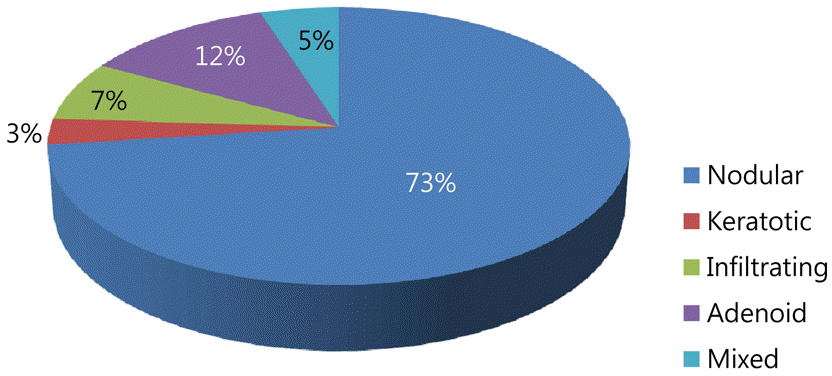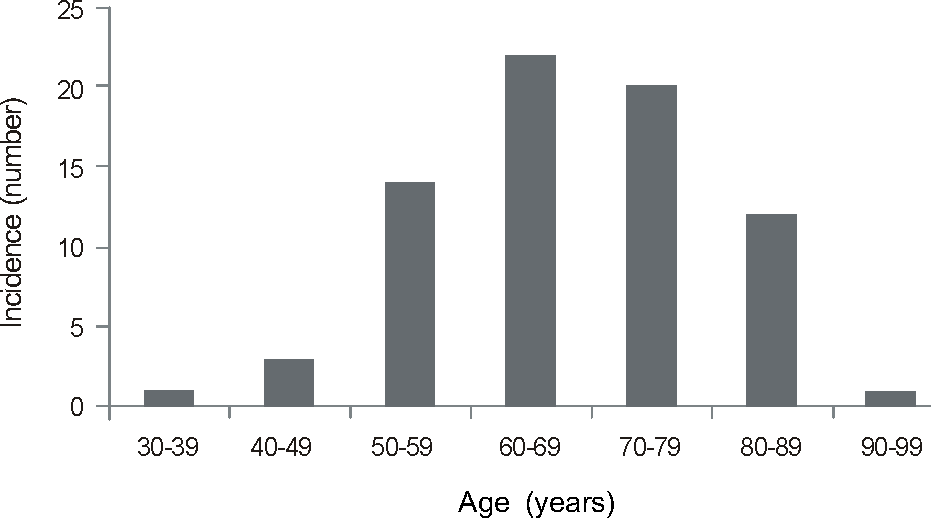Abstract
Purpose
To determine the clinical characteristics of patients with malignant eyelid tumors in Korea.
Methods
We performed a retrospective review of the medical records of 73 patients with malignant eyelid tumors who were histologically diagnosed at Seoul St. Mary’s hospital from April 2004 to September, 2012 and followed for 6 months or longer.
Results
Of 73 cases, 41 (56.2%) were diagnosed as basal cell carcinoma, 17 (23.3%) as squamous cell carcinoma, 11 (15.1%) as sebaceous gland carcinoma, 3 (4.1%) as malignant melanoma, and 1 (1.4%) as basosquamous cell carcinoma. The mean age at diagnosis was 68.4 ± 11.5 years. Tumors developed more commonly on the lower lid (54.8%). Most cases were treated by complete resection of tumors and eyelid reconstruction (95.9%). The prognosis of patients with basal cell carcinoma and squamous cell carcinoma was good, while that of the other tumors was relatively poor.
Go to : 
References
1. Kersten RC, Ewing-Chow D, Kulwin DR, Gallon M. Accuracy of clinical diagnosis of cutaneous eyelid lesions. Ophthalmology. 1997; 104:479–84.

3. Lee SB, Saw SM, Au Eong KG, et al. Incidence of eyelid cancers in Singapore from 1968 to 1995. Br J Ophthalmol. 1999; 83:595–7.
4. Lin HY, Cheng CY, Hsu WM, et al. Incidence of eyelid cancers in Taiwan: a 21-year review. Ophthalmology. 2006; 113:2101–7.
5. Takamura H, Yamashita H. Clinicopathological analysis of malignant eyelid tumor cases at Yamagata university hospital: statistical comparison of tumor incidence in Japan and in other countries. Jpn J Ophthalmol. 2005; 49:349–54.

6. Mak ST, Wong AC, Io IY, Tse RK. Malignant eyelid tumors in Hong Kong 1997-2009. Jpn J Ophthalmol. 2011; 55:681–5.

7. Lee HK, Hu CH, Kang SJ, Lee SY. Clinical analysis of lid tumors. J Korean Ophthalmol Soc. 1997; 38:1892–8.
8. Oh JS, Cho KH, Lee JB. Malignant tumors of the eyelid. J Korean Ophthalmol Soc. 1981; 22:733–40.
9. Lee SH, Kim MS. The malignant tumors of the eye. J Korean Ophthalmol Soc. 1977; 18:327–33.
10. Roh KK, Lee JH, Youn DH. Clinical analysis of tumors of the eye and its adnexa. Korean J Ophthalmol Soc. 1988; 2:27–31.

11. Lee TS, Lee JJ. Analysis of classification and incidence of eyelid and orbital tumors. J Korean Ophthalmol Soc. 1997; 38:1700–5.
12. Kim KH, Chung WS. Classicification and therapeutic effect of benign and malignant eyelid tumors. J Korean Ophthalmol Soc. 1997; 38:703–9.
13. Kale SM, Patil SB, Khare N, et al. Clinicopathological analysis of eyelid malignancies-A review of 85 cases. Indian J Plast Surg. 2012; 45:22–8.
14. Cook BE Jr, Bartley GB. Epidemiologic characteristics and clinical course of patients with malignant eyelid tumors in an incidence co-hort in Olmsted County, Minnesota. Ophthalmology. 1999; 106:746–50.

15. Margo CE, Waltz K. Basal cell carcinoma of the eyelid and peri-ocular skin. Surv Ophthalmol. 1993; 38:169–92.

16. Ni C, Searl SS, Kuo PK, et al. Sebaceous cell carcinomas of the ocular adnexa. Int Ophthalmol Clin. 1982; 22:23–61.

17. Lee TW, Yang SW, Kim BH, Song JS. A clinicopathologic study of 46 cases of eyelid malignancy. J Korean Ophthalmol Soc. 1995; 36:2087–94.
18. Reifler DM, Hornblass A. Squamous cell carcinoma of the eyelid. Surv Ophthalmol. 1986; 30:349–65.

19. Newton R, Ferlay J, Reeves G, et al. Effect of ambient solar ultra-violet radiation on incidence of squamous-cell carcinoma of the eye. Lancet. 1996; 347:1450–1.

20. Lee JJ, Kim NJ, Choung HK, Khwarg SI. Clinical features and management of eyelid sebaceous gland carcinoma. J Korean Ophthalmol Soc. 2008; 49:183–9.

21. Cook BE Jr, Bartley GB. Treatment options and future prospects for the management of eyelid malignancies: an evidence-based update. Ophthalmology. 2001; 108:2088–98. quiz 2099-100, 2121.

22. Kass LG, Hornblass A. Sebaceous carcinoma of the ocular adnexa. Surv Ophthalmol. 1989; 33:477–90.

23. Shields JA, Demirci H, Marr BP, et al. Sebaceous carcinoma of the eyelids: personal experience with 60 cases. Ophthalmology. 2004; 111:2151–7.
25. Kwitko ML, Boniuk M, Zimmerman LE. Eyelid tumors with reference to lesions confused with squamous cell carcinoma. I. Incidence and errors in diagnosis. Arch Ophthalmol. 1963; 69:693–7.
Go to : 
Table 1.
Histopathological classification of malignant eyelid tumors treated at Seoul St. Mary’s Hospital
Table 2.
Histologic findings of squamous cell carcinoma
Table 3.
Sex distribution of malignant eyelid tumors treated at Seoul St. Mary’s Hospital
| Men | Women | |
|---|---|---|
| Basal cell carcinoma | 10 | 31 |
| Squamous cell carcinoma | 5 | 12 |
| Sebaceous carcinoma | 4 | 7 |
| Malignant melanoma | 0 | 3 |
| Basosquamouscell carcinoma | 0 | 1 |
| Total | 19 (26.02%) | 54 (73.9%) |
Table 4.
Location of malignant eyelid tumors treated at Seoul St. Mary’s Hospital
Table 5.
Primary Treatment modalities of malignant eyelid tumors treated at Seoul St. Mary’s Hospital
Table 6.
Frequency malignant eyelid tumors reported in different studies




 PDF
PDF ePub
ePub Citation
Citation Print
Print




 XML Download
XML Download